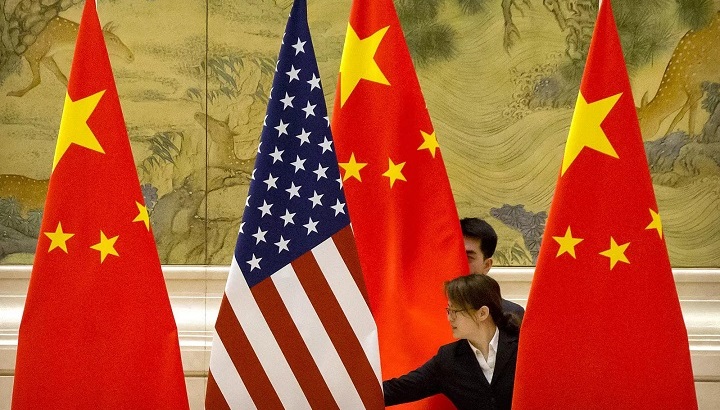
Parallel yet different challenges await President Xi Jinping and President Joseph Biden in their respective countries, China and the United States, next year.
At first glance, the two leaders are guiding the two countries in very different directions. One, Biden, faces an uphill struggle to hold America steadfast while China could more easily go downhill on the path of stability. Yet, with a closer look, things could be different.
Diverging perspectives
In China, Xi secured his position for life, and nobody in his right mind will challenge him for that, at least in the foreseeable future. This should make China, in the next few years at least, extremely stable and secure from any major political upheaval.
Yet, this concentration of power in the hands of one man actually makes many things uncertain. Yes, Xi Jinping is the pinnacle of Chinese power, the keystone of the bridge. Yet the architecture of the bridge, the design of future Chinese power, remains uncertain.
We don’t know the structure of the next Standing Committee of the Politburo, the summit of Chinese power, the one that takes day-to-day decisions. Presently, it is made of seven people, and up to six of them could retire at the congress next autumn. Then here starts the problem.
Will the new Politburo be made just of seven people, or will it get smaller, to five? In the past, it was even expanded to nine people. The numbers are not indifferent, “five people” means a very fast and efficient decision-making process. Yet the format of five people could be too small for the responsibilities of China now.
If they are seven, will they all be younger, much younger than Xi Jinping and different from the present six? They will all owe their careers to Xi himself. Unlike the present Politburo, where they are all in Xi Jinping’s age bracket and moved up the ladder thanks to promotions made by Xi’s predecessors, the new Standing Committee will be even more deferential to Xi.
In this situation, Xi, who could possibly be appointed chairman of the Chinese Communist Party (CCP), will have to design power differently. Even thinking of his age and the long-term prospects of the power structure, he may want to have a general secretary in charge of day-to-day business, so that he would be one step removed from power and intervene only on sensitive matters. Xi, who will be 69 next year and is certainly overwhelmed by office matters, will have to pace himself and keep his health for the next decades.
He then may want a configuration in which he is not formally part of the Standing Committee, and then he is eased out of the daily strain, but retains an external power of veto and direction. That is, the organization of the Standing Committee could be of five people, but Xi could intervene with extra control and a substantive vote in delicate matters.
This structure saves Xi from excessive burdens, but opens him to possible plots by the five-member Standing Committee. In politics nobody is dead sure of anybody. The five people who could run China on a day-to-day basis, at a certain point could decide against Xi in Xi’s absence. In Chinese politics, no leader was safe from betrayal. Mao Zedong was deceived or felt so by his pals Liu Shaoqi and his devoted Lin Biao, who separately tried to remove him from power in the 1960s and 1970s. Similarly, Xi Jinping, facing possible difficult domestic and international choices, could be sidelined by a riotous new Standing Committee.
To actively prevent that, Xi could still be part of the day-to-day work, but this of course will take a toll on his energies because he will have to supervise and decide on everything without time for gradual rest in sight. That is, if he keeps \ running China on a daily basis, then the next Party Congress in five years could be a momentous moment, because at the age of 74, possibly stressed and very tired, Xi will have to manage a new batch of Chinese leaders who naturally will have their own ambitions and their own ideas about the country. That is, he would make his own position more difficult in five years’ time, although in the next five years, it could be more secure.
On top of that, there are difficult decisions about who will be in the 2022 Standing Committee. Premier Li Keqiang should go, as all people of his age go. Yet he has not reached his age limit, so he might resist being retired. The newly enlarged Politburo will have about 25 more members, and they will have to be chosen and vetted one by one by Xi. This means also that if Xi Jinping makes a mistake on any of them, the mistake will be on him. The same is true for Central Committee members, about 300 people. About half of them will have to step down, and this again means a huge strain on Xi: vetting and choosing 300 people one by one. If any of them turns out to be corrupt or inadequate, the mistake will be his own.
In theory, to avoid all these possible traps, Xi could choose an altogether different construction, not one in which he is the keystone of the bridge, structurally important for holding the arch. Maybe he should choose to keep aloof and open a division of power in which for instance the prime minister and the party secretary separately run the government and the party, yet all report to Xi. This structure would naturally create conflict and friction between the party secretary and the prime minister, and that friction, if not handled openly, could start political conspiracies that would weaken the system anyhow.
Then the system could be secured by having both party and government matters reported openly,
not only to Xi Jinping but also to the public, thus limiting chances for conspiracies and plots, which thrive in secrecy.
This will prick the attention of the Chinese public to domestic matters and could draw the attention of the press and of the people stressing their sense of belonging to a political community they really know nothing about. This will not be “Western-style” democracy, but it will still be a new interesting feature of Chinese politics that could give greater stability to the country. This greater stability will have to pass the test of time to see how it works out.
But these are just ideas. The Communist Party will certainly have other ideas, different ones. Whatever the ideas are, the solitude of Xi Jinping’s power creates a new set of troubles for the structure of Chinese rule, and this should be resolved with a stable structure that can last a few years. Still, the solution is not yet there, and we don’t know what it will be and if it will work.
US stable politics
American politics is in a very different position. Biden and the Democratic Party are facing a massive defeat in the midterm elections. The Democratic Party could lose the majority in the House of Representatives and perhaps also in the Senate. Therefore, the president might lose the support necessary to carry out his policies.
Biden is challenged by a surge of inflation and migration that is moving voters to the Republican camp. Biden’s policies are controversial and still new. They are not making a dent in public opinion, and without the necessary support, the Democratic party in three years may lose the presidential election.
Still, this earthquake could be very positive for America’s political stability. The biggest threat to this is not the Democratic Party or the Republican Party, but the presence of Donald Trump who with his erratic behavior and unorthodox and perhaps illegal methods has been derailing traditional American politics. If the Democratic Party loses the midterm elections, the Democrats may lose the presidential election in three years, but the Republican party doesn’t need Trump to win. Any Republican presidential candidate could beat Biden if he chooses to stand for reelection or whoever the Democrats decide to fill in.
If the Republicans do not need Trump to be politically effective, then they could move back again to the center of the political spectrum. This fact could help collaboration between Democrats and Republicans for common moderate policies that would help America find a new middle ground internally and externally.
This middle ground will have to take care of the new social and wealth divide in the country. The ultrarich are monopolizing wealth and opportunities and ignoring the needs of the common people. They are drying up the middle class that for over a century was the backbone of American society. Without that backbone, America is no longer that.
The new middle ground between moderate Democrats and moderate Republicans has to address the needs of the people who do not feel represented by the present political social and economic system, who are disenfranchised, who feel disposable, expendable, and believe they are represented only by the new radicals, left and right.
The moderates then have to dry up the left and right wings, by catering to the actual needs. This will be difficult, not easy, but if done earnestly in the next few years, America should find its path forward. That is, despite the apparent uncertainties, a greater political certainty is surfacing in the United States that could take the country on a stabler path in the next decade or so. Just the opposite may be looming in China, if not corrected and addressed, in the same period of time.
Give us a policy
Still, in both countries, what really matters are policies, and here both countries have difficult choices to make. Xi Jinping, as soon as he came to power in 2013, tried to tackle the issue of the State-Owned Enterprises (SOEs), which are the basis of economic, social, and political distortions in China. Yet in 2013 he failed to reform the SOEs, and now those problems have become even larger.
One great drive of Chinese economic growth has come to a virtual halt: the development of the real estate sector. The pending default of the real estate company Evergrande, with over US $300bn of bad debt (more than 90% domestic), is just the tip of the iceberg. Real estate accounts at least for 30% of China’s GDP[1]. Private, semi-private, and public real estate companies sit on a Himalaya of overextended loans, shared by banks and local governments. If the central government lets them go to clean the market, this could trigger a landslide of unfathomable proportions. The slide would not only be domestic but also external.
Yes, the RMB (the Chinese currency) is not fully convertible, and thus a capital flight that could immediately crash the economy is impossible. But China has about US $700 bn of external debt, of which quite a sizable amount is to be paid by these failing companies and banks, not just the central government. Beijing has hundreds of companies listed abroad and they could suffer immensely in a rush out of “China’s Capital, Inc.” Hong Kong, although not as functional as a few years ago, is still the main hub of exchanges between China and the rest of the world with its modern financial system. A flight from “China’s Capital, Inc.” could crash Hong Kong’s economy.
These three liabilities could bring poverty to the country, and to its large middle class, the solid base of the CCP’s hold on power. Moreover, this could also crash its main source of revenues, external exports. At the same time, China needs to address its economic structure. Exports are still hugely important for the country. Internal domestic consumption is not picking up at the desired pace. But it is unsustainable as there are not enough markets in the world to buy Chinese goods.
These issues, even without looking at the international tensions that are building up and the problem of Covid that doesn’t go away, are immense challenges to be addressed by the new Politburo.
US fundamentals
The United States has different problems. Its companies are extremely successful and innovative, yet their success is killing opportunities for smaller entrepreneurs and high-paying jobs, and it is all taking away hope from the American public.
Without hope, children do not study, they don’t make an effort, and they lean back. The challenge of this massive plan of infrastructure building and relaunching education is to give hope to the American public and also to the world looking to America. A new massive plan as it is being perhaps outlined now could address it.
On the surface, China is different. Chinese young kids are eager to study, work very hard, and are extremely motivated. Still, there are two signs of long-term problems that need attention. One is the generation of young urban kids who wish to “lay flat,” do not have any ambition, do not strive, and are happy living off their parents and grandparents.
These kids do not have ambition because they were pampered but also because they were under unbearable strain by their families and having failed to fulfill the dream of being first in their class or first in their job. They feel they are a failure and therefore they have nothing to strive for. In a country where to be first is everything, and there is little or no room to be second or third, and the second and third lose their motivation and feel there is no need to work hard.
This lack of motivation is also reflected in the drop in birth rate. China has dropped its one-child policy, and in fact it is making it difficult for couples to have an abortion. Beijing feels the country is aging before it is getting rich, and now the government is trying to buck the trend. However, it could turn out to be difficult.
Children are very expensive to raise in China. Hospitals are expensive, schools are expensive, and therefore having two or three children could be an unbearable load on the families. Already now families earmark over 1/3 of their income for their one child. Having three children means they have no money left for food. Then, to have more children, China should at the very least make schools and healthcare free. But this brings new burdens on the system already under strain for the inefficiencies of real estate and state-owned enterprises. Still, as China is a closed economy and has a huge trade surplus and massive spread between interest on deposits and loans, it could sustain the situation for quite some time.
This is just an accounting problem, and that may turn out not to be enough. Unless society becomes less oriented around success and being number-one, children may have problems carrying on working hard if they are not top of their class. That is, China has to become structurally less of a pyramid, less “singularly meritocratic,” looking at merit only as success in public service, or in business. Chinese society has to be more open and diverse to inject new hope in the children who feel left behind because they are not so good in mathematics in primary school. These are tremendous social and anthropological changes which in the past China proved able to face. At the moment, we don’t know.
On the other hand, economically it should find new patterns of growth tapping into its very dynamic private enterprises. China should give more opportunities to private companies providing them with a fairer level market system, where they don’t have to seek political patronage to gain market share. The old patronage business system is gone and a new one is still uncertain. Politics should withdraw from the economic fields, and this could also be reflected in a separation between government and party affairs on top. How this could work out is of course open to question.
USA challenges
American challenges are different: the failures of its foreign policies and the financial crisis, starting in 2004 to 2008 and all the way through to the support of the Jasmine revolutions in the Middle East, have undermined American clout in the world. Unlike China, America is a national and international entity, and the two are linked together. Then, if America doesn’t take back its international prestige, this could also weaken its domestic policies. Here Biden has started launching new ideas, but ideas like Built Back Better World (3BW), a worldwide network of infrastructure, are still not real.
The United States is losing political ground in Latin America and Europe, traditionally its home turf. In Africa, it is not faring any better. The United States is gaining traction in Asia, where it was losing ground for a long time. Yet, this may not be enough. America needs to be everywhere and stronger to keep itself ahead.
Here the old social order, based on strong communities caring for their own, which keeps the state at bay, is unraveling. The state is required to provide new, more expansive services, for which it needs more money and more social intervention. The idea of social welfare provided by the state, first introduced by social democracies and by Bismarck’s Germany, is expanding. People believe that old services, once private, are better performed by the state (education or health, but also police or defense). The state is less about setting rules that independent economic-political players will use fairly, and more about managing limited resources and central mediation between conflicting social forces.
The old liberal order was based on the idea of a light state that would care only about setting the rules. Services and welfare were provided by families, strong and large, and by churches or religious organizations looking after the ones who were left out.
Even in China, without organized churches, villages, clans, and guilds provided social services without interference from the state. The weak, light state was thus grounded on strong churches and strong families.
Socialism in the 19th and 20th centuries introduced the idea of the state caring for everything, and capitalist societies adopted it, seeing its positive side in providing public cohesion and a new social contract. Bismarck’s caring state, with public schools and free basic health care, created the first mass program for social improvement of the quality of the population. The people, by being better educated and in better health, improved the state productivity and innovation in all social aspects.
But if the state has to provide health care, unemployment benefits, free school, et cetera, then, the foundations of liberalism will start shifting. What is liberalism if the state is required to look after everything and everybody? It is more than the lure of a totalitarian state; it is the balancing act about where there is and where there can be free initiative.
This is shaking the foundations of America, born out of this free spirit.[2] Here, technology brings us also beyond the interventionist state. Society itself is replaced by networking on the web, and social interactions with phone chats. Social control by elders or police informers are replaced by phone tracking and cameras with facial recognition.
The state provides for all, perhaps even rightly so, and the internet drains and transforms society. But all of this creates a sentimental desert.
Human cordiality and relations are gone. Man, basically a social, political animal, is maimed and torn. This provides a new role for religion in society: delivering warmth, attention, care, and being a field hospital. The present path of the Catholic Church is apparently set on filling this yawning gap.
This is immensely strong in America and Western society, where the responsibilities of different institutions are blurred and overlapping, but it is also present in China where the state has a stronger and clearer role.
It is hard to say which challenges are more difficult, the Chinese or the American ones. But in the next few months at least, we shall see who will move ahead of the other.
[1] https://www.economist.com/finance-and-economics/2021/11/27/measuring-the-universes-most-important-sector
[2] See also https://www.theguardian.com/society/2021/nov/25/society-thatcher-reagan-covid-pandemic





